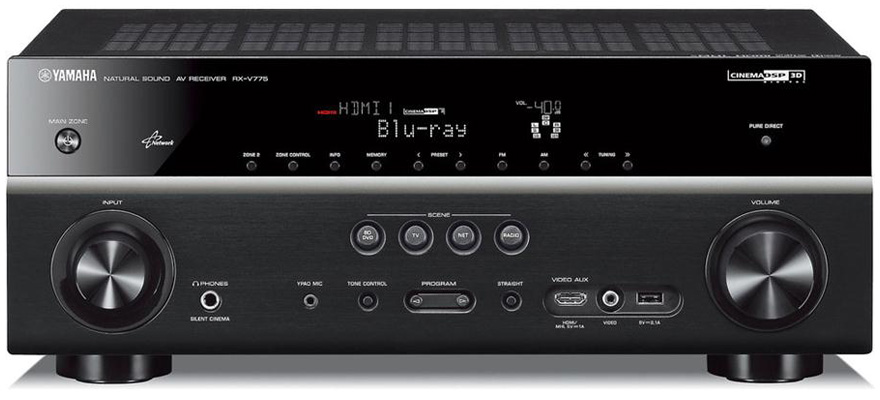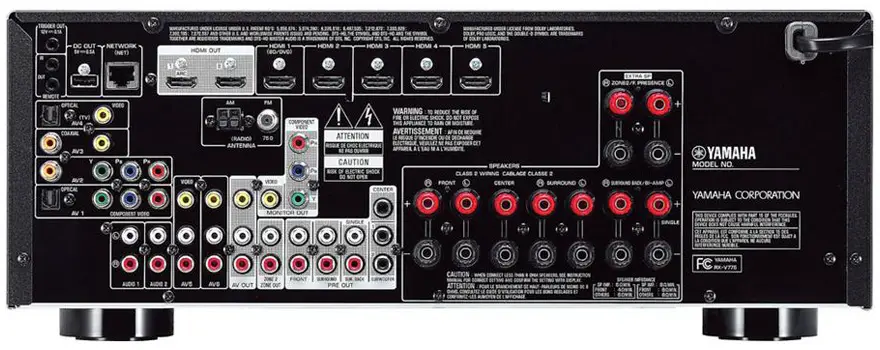In 2012, Yamaha released the RX-V773WA home theater receiver with much fanfare as it featured a wireless USB adapter, AirPlay support and a refined speaker calibration system. The audio performance measured up well with the competition and it was apparently enough for Yamaha to only make very minor improvements to its successor. The Yamaha RX-V775WA is definitely not a receiver that existing RX-V773WA users should buy but it is a more polished product that deserves a recommendation if you haven’t purchased an AV receiver yet.

Design
The RX-V775WA looks completely identical to the RX-V773WA from the front. The model name is shown on the upper left so you should read that carefully to really see if you are getting the Yamaha RX-V775WA. Since this receiver features more HDMI inputs than the other budget Yamaha receivers, there is an input selector knob on the bottom left. But it is best to configure the 4 SCENE buttons on the front so you can switch to your favorite source such as the Blu-ray player immediately while applying a DSP mode. These buttons can be found on the remote as well.
One very subtle difference with the RX-V775WA is the MHL label shown right under the front HDMI input. This input extends the compatibility of the HDMI port to the newest smartphones and tablets that rely on the Mobile High-Definition Link for outputting audio and the device’s screen to the TV. An MHL cable is required so you can connect the HDMI cable to the device’s microUSB port. With this type of connection, you can play back HD video from the mobile device while keeping it charged. It is the sole new feature present in the Yamaha RX-V775WA but it is something significant for Android fans since the AirPlay wireless technology is only exclusive for Apple devices. The other 5 HDMI inputs don’t have the MHL compatibility but they still have the latest standards so you can hook up the latest components that support 3D and 4K resolutions.
The RX-V775WA also features the same set of connection ports and terminals as its predecessor but the arrangement is more organized. For instance, if you want to set up a pair of front presence speakers or a Zone 2, you can easily spot the connections just above the main set of speaker connection ports.
Below is the back panel layout. Click on image to enlarge for a clearer view.

Features
The Yamaha RX-V775WA is the only receiver in the 2013 Yamaha entry-level category that is packed with dual HDMI outputs. This enables HDMI Zone B operation where you can output whatever the content is shown on your main TV to another TV that may be placed in another room. Zone 2 support is only limited to audio which means that you can still play music independently in another room with a 2.1-channel speaker system without interrupting whatever source is being used in the main room. Enabling Party Mode will simply mirror the audio from the main source to Zone 2. With 105 watts per channel, you may also setup a 7-channel surround sound system to really maximize the receiver’s audio performance. Plenty of audio codecs and formats are supported ranging from the usual DTS-HD Master Audio and Dolby True HD to advanced ones like DTS Neo:6 and Dolby Pro Logic IIx which convert stereo content to surround sound formats.
The YPAO Sound Optimization feature present in the RX-V775WA pretty much functions like other calibration technologies where a microphone is used to capture sounds from a series of speaker tests so proper adjustments can be made. But calibrating with the Yamaha RX-V775WA is a little bit more sophisticated thanks to the Reflected Sound Control which corrects early reflections to achieve studio-like audio quality. Multi-point calibration is supported as well.
The RX-V775WA also boasts a few video processing enhancements to improve the quality of high-definition playback. Edge adaptive deinterlacing is a special deinterlacing technique that is more reliable in removing jaggies. It is also capable of upscaling analog and other non-HD sources to 1080p. Add a 4K display to the receiver and content can be upscaled to Ultra HD resolutions too.
There are no exclusive networking features present in the Yamaha RX-V775WA that the cheaper entry-level Yamaha models don’t have but the RX-V775WA comes with a free YWA-10 Wi-Fi adapter so you won’t need an Ethernet cable to connect the receiver to the home network although it still remains as an option. This adapter works great with the AirPlay support because AirPlay is included in all modern Apple iOS devices too allowing you to stream music over the air without any messy wires. The Compressed Music Enhancer does a fantastic job in improving the quality of lossy formats. If you are a fan of lossless formats, the Yamaha RX-V775WA supports them as well.
The RX-V775WA does not have its own Web browser but you can still access popular Internet radio services like Pandora, vTuner and Rhapsody. Your iOS or Android device can also link to the receiver through the Yamaha AV Controller app which comes with a friendlier interface than the remote control.
Maximizing the performance of your Yamaha RX-V775WA can affect energy consumption but you can manage it by turning on the ECO mode which consumes 20% less energy while putting a cap to the audio power and volume level. Numerous standby functions are also available if you want to save more electricity but enable certain functions like networking or input source switching.
Bottom Line
The Yamaha AVENTAGE lineup represents the true high-end category where you have more HDMI inputs and studio grade sound. But if you are not willing to spend more than $1,000 for these receivers, the RX-V775WA comes pretty close and the $799 price tag makes this receiver more of a good deal especially if you consider the free Wi-Fi adapter. It is a great receiver for high-definition movie lovers and even gamers that want a compelling audio experience. Even if you discover a cheaper and older RX-V773WA in a store, you are better off going for the Yamaha RX-V775WA since the MHL standard will rise in popularity as more smartphones and tablets implement it.